First Light - June 12, 2006
I finished the mirror on Saturday, June 10th. At about 5:15pm on
Monday the 12th, I backed my car out of the garage and headed for Bob's
house with the finished (but uncoated) primary mirror safely crated and
in the back of my car. (Thanks to John Stone for helping me crate
it and carry it up the stairs!) I arrived at Bob's about an hour
later. Some high clouds floated past intermittently, but there
were holes and we knew it wouldn't prevent us from having our first
look through the new instrument. For the most part it was a
beautiful evening, with a light breeze, pleasant temperatures, and
clear enough skies - in short, a beautiful night for first light.
I think we all knew it was going to be a memorable night. Here's
the view I arrived to, telescope in the open observatory, secured and
pointed skyward, ready to have the primary and cell installed.
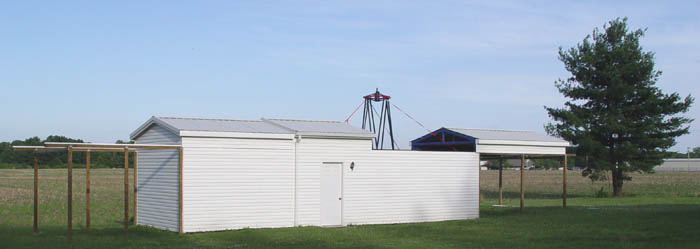
We soon set about preparing to install the primary mirror in the
telescope. Below in the first photo Bob is cleaning particles out
of the cell - before
the primary was installed a concrete "mirror" was sitting in it for the
purpose of balancing the telescope, and we didn't want any bits of
concrete left in the cell. The mirror was uncrated and carefully
carried into the observatory and
set into its cell. Here are Bob (left) and John (right) just
after it was set onto its supports. Next, the other three side
supports were installed. It turned out they were set just a bit
too close to the mirror, because we found later we had pinched the
mirror! Oh well, we'll get it right when we install it after it
is coated! Below is the photo of them and their reflections in
the UNCOATED mirror. Bob put in countless hours planning,
designing and crafting every detail the telescope. John helped
with machining of various parts of the scope, especially the drive
system, and he spend a great deal of time making the mirror grinding
machine that I used to grind, polish and figure the mirror. These
two guys are basically responsible for every mechanical detail of the
telescope, and their effort, as amateurs, is to be commended. I
was only responsible for the mirror, which was a relatively small time
commitment compared to the hours they put in!
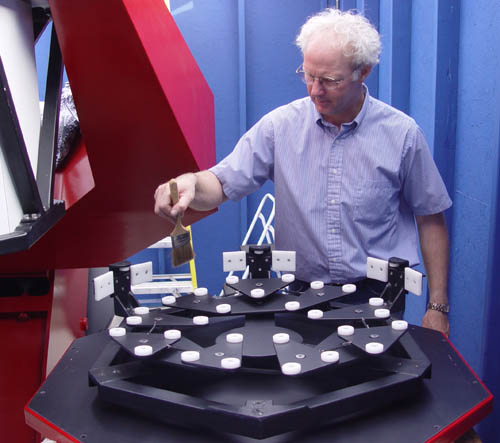
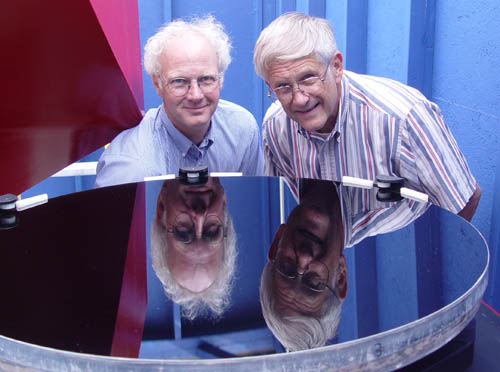
Next the mirror and cell, which were sitting on a special lifting table
that Bob had built utilizing a hydraulic jack, were rolled under the
back of the scope and carefully jacked up into contact with the
telescope. Bolts were tightened, and the table was dropped and
removed. Assembly was nearly complete. Below is an image of
the raising of the primary and cell.

Collimation was tuned using a laser collimator, and an eyepiece was
inserted in the focuser. Now, you should realize that this scope
is intended for pure imaging use, so to use an eyepiece it is inserted
in a focuser that lies in the center of the upper end of the tube,
where the secondary of a Newtonian would normally be. This means
to look into it you're quite high off the ground, looking back down at
the primary. Also, this telescope is not meant to ever point near
the horizon, since the imaging it does for research purposes is best
done above a certain altitude.
With an eyepiece ready to go, Bob slewed the scope to Jupiter, which
was shining brightly in the south, just over the roll-off roof.
At approximately 8:45 pm, he climbed the ladder with a low-power
eyepiece, moved the scope a little, and enjoyed first light. The
moment is captured in the photo below at left. We all took our
turns having a look, which was very nice considering the uncoated
mirror, and the fact that we each constituted a very, very thick spider
vane due to our viewing position! Below at right is a night shot
of the scope, showing counterweights on one of the fork arms, and
Jupiter shining at the upper right. We concluded that the mirror
was definitely ready for the coater, as my test results had indicated.
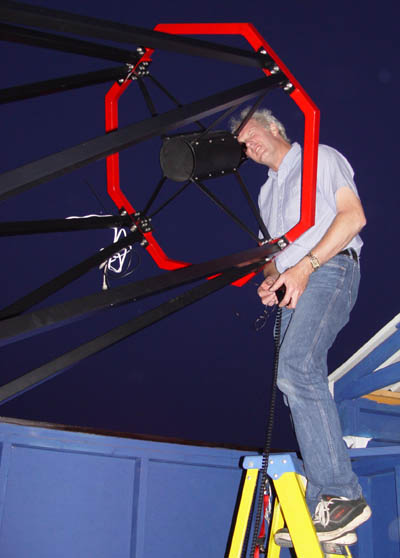
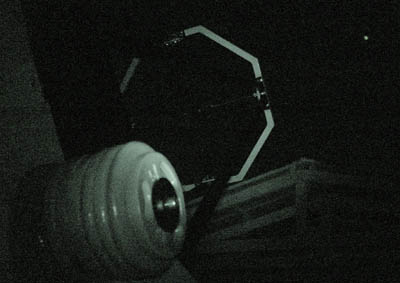
Later on we used a webcam to check out Jupiter and grab some frames,
but in doing some star testing we saw that the image had the look of a
pinched optic. The only optical element (other than a coma
corrector) was the primary. Closer inspection revealed that the
primary was pinched in its cell, but it was time to pull it out and
recrate it so it could head off the coater the next morning. I
speculated that the condition had worsened as the night went on and the
cell cooled, shrank a bit, and squeezed the mirror even more.
Overall I was impressed with how generally bug-free the new telescope
was - it moved and tracked fairly well, and we got the collimation
close enough to see Jupiter nicely. As the optician, I was also
happy to see a nice view of Jupiter and to help debug the cell pinch
(in spite of which Jupiter looked fairly good).
We eagerly await the coated mirror's return and the first
full-aperture, high-quality images it captures. I think it will
have a long, productive life channeling starlight, and I can't wait to
see it gathering useful data.





